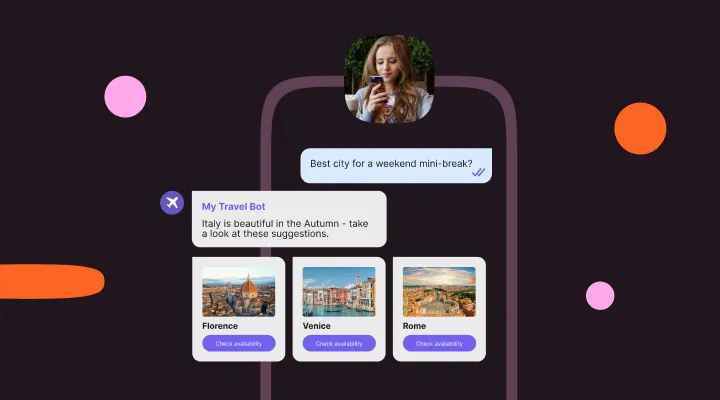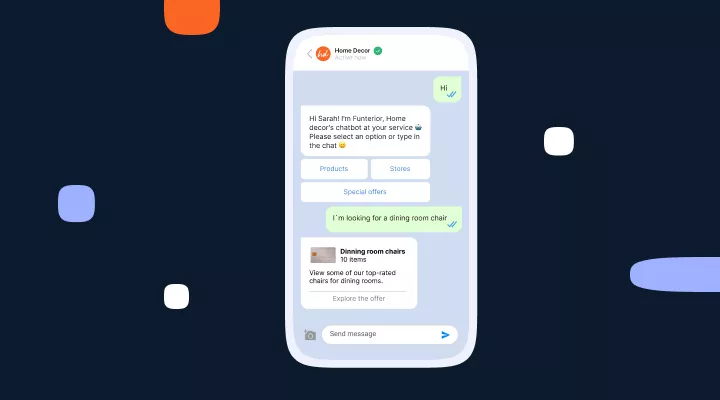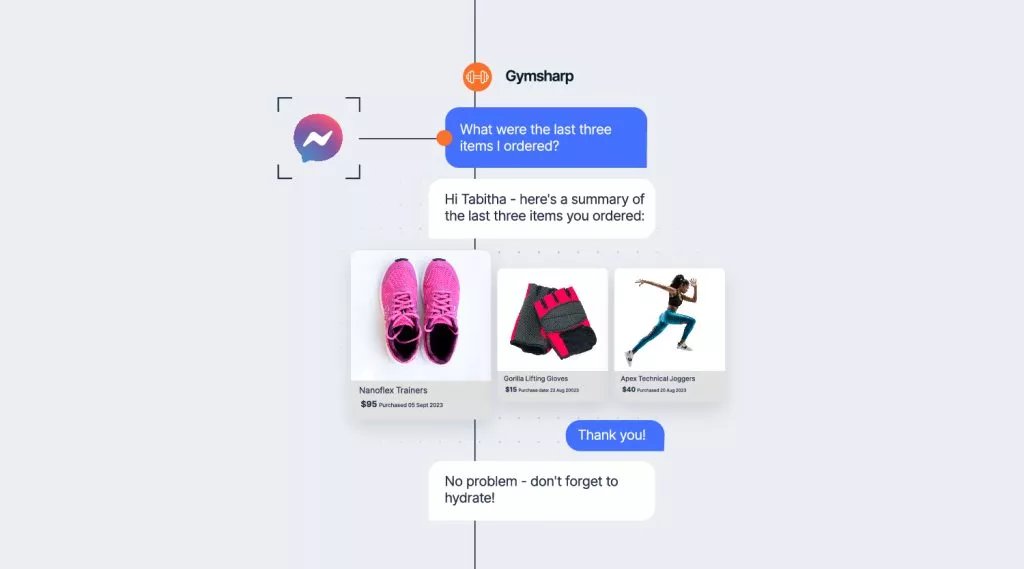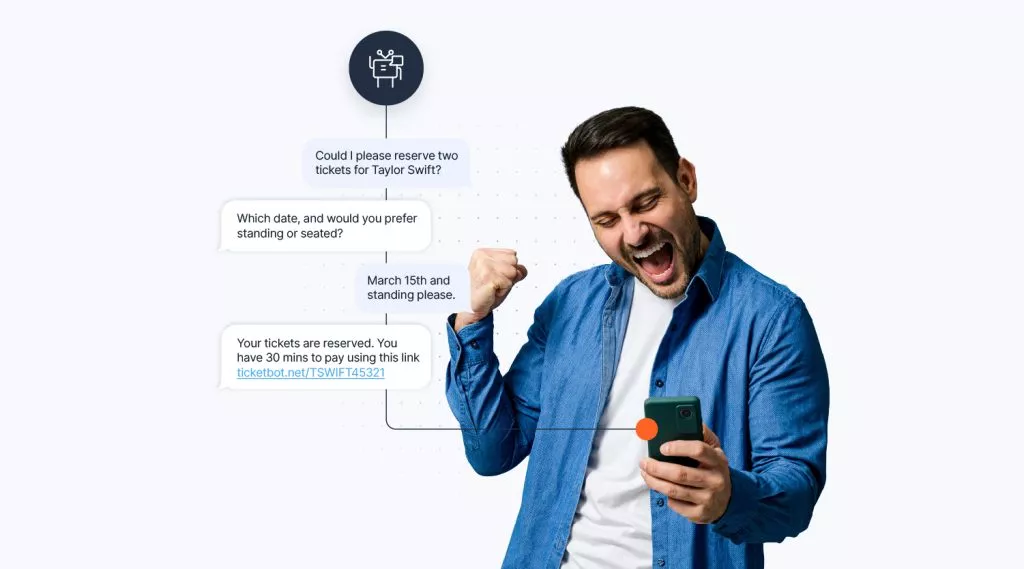What is an AI chatbot?
An AI chatbot, also known as a conversational chatbot or an intelligent virtual assistant, is an intent-based computer program that uses artificial intelligence to bring a conversational approach to customer service.
What are the different types of chatbots?
There are six types of chatbots:
- Menu/button-based chatbots – this is the most basic type of chatbots implemented on the market. They have a knowledge base with questions that are presented to users as buttons and require the user to make several choices before the final answer.
- Linguistic-based/rule-based chatbots – create conversational automation flows using if-then logic. For your customers to receive proper support, you need to define the language conditions of your chatbot (the order of words, synonyms, etc.).
- Intent-based chatbots/keyword chatbots – utilize customizable keywords and AI applications (natural language processing (NLP)) to determine how to reply to a query properly.
- Machine learning chatbots – are far more advanced than the previous three chatbots. This type of chatbot utilizes machine learning (ML) and artificial intelligence (AI) to memorize conversations with users, generate coherent answers, and grow over time.
- The hybrid model – is a combination of rule-based chatbots and AI bots.
- Voice bots – rather than typing, these types of bots are triggered by speech.
How does an AI chatbot work?
An AI-powered chatbot combines machine learning, natural language processing (NLP), and natural language understanding (NLU) to understand user intent, extract essential information, and respond to an inquiry in a natural, conversational way in real-time.
However, for a chatbot to effectively learn from customer interactions and improve, it will need access to a wide range of data.
AI chatbots use large language models, predictive intelligence and analytics to analyze conversations, customer support documentation, and any other data to understand a customer query’s language, context, and intent.
This means that when a website visitor asks a question, the chatbot can understand what they want and respond appropriately.
Meaning, they are more useful where customer questions are likely to change.
In conclusion, they:
- Learn user’s preferences over time
- Provide recommendations
- Monitor data and intent
- Initiate conversations
What are the benefits of AI chatbots?
In short, AI chatbots can:
- Provide multilingual support 24/7
- Provide a personalized experience
- Provide consistency
- Qualify leads
- Improve customer support
- Improve time-to-resolution
- Improve lead generation
- Improve sales
- Gather information
- Reduce waiting time
- Reduce bounce rates
- Reduce spending
What is an AI chatbot used for?
AI chatbots can be used for:
- Branding
- Lead qualifying
- Candidate vetting
- Onboarding
- Automating routine tasks
- Sales
- Customer support
- Marketing messages
The ultimate guide to generative AI chatbots for customer service
Learn how generative AI, agentic AI, and agentic RAG technology are transforming CX. Explore use cases, benefits, risks, and best practices.
Chatbot for marketing: How to get started?
Ready to boost your marketing game with a chatbot? Learn the basics of getting started with chatbots and how they can benefit your business.
How do you build an AI chatbot?
Read our series on how to build chatbots for various channels:
How to use AI chatbots across industries
AI chatbots are a fantastic solution for any industry because of their versatility. Train and manage your AI chatbot and use cases as you see fit. Check out a few industries that benefit from these intelligent assistants:
AI chatbots for healthcare: A guide for medical centers and healthcare providers
Learn how AI chatbots help healthcare providers boost patient care, efficiency, and privacy. See real-world examples and tips for safe medical chatbot integration.
How AI is transforming the telecom industry
AI is transforming the telecom industry by driving smarter networks, hyper-personalized customer experiences, and proactive security. Learn how AI is helping telcos boost efficiency, cut costs, and innovate at scale.
How retail chatbots can personalize shopping experience
Shoppers expect quick, helpful responses. Retail chatbots have become a popular tool for brands to meet that demand. Learn how they’re transforming the way companies interact with their customers.
Why your hotel needs a chatbot
Learn how artificial intelligence is disrupting the hospitality industry and how chatbots can help hotels exceed customer expectations while lowering costs.
Demystifying finance AI chatbots for fintech firms
Finance AI chatbots are redefining how financial businesses serve customers. Does this mean your fintech company needs a finance AI chatbot? Find out in this blog.
Supporting back to work initiatives with HR chatbots
HR chatbots can help you manage your workforce, whether in-office, hybrid or remote. Here’s how!
What is the difference between rule-based and AI chatbots?
Rule-based chatbots can be seen as the digital equivalents of the interactive voice response (IVR) system. They use a series of if/then statements for action-taking. With this, rule-based chatbots can easily and quickly provide specific and detailed information. Some use cases of rule-based chatbots include customer service, sales support, engagement, and two-way interactions.
When someone interacting with a rule-based chatbot does not know precisely what they want, they become less helpful. Then conversational or intent-based chatbots come in handy.
Conversational chatbots use natural language processing (NLP) to determine a person’s intent. To achieve that, a chatbot successfully recognizes a person’s goal; it must be trained to identify every possible version of the same intent.
| Traditional chatbots | AI chatbots |
|---|---|
| Basic answers and responses | Complex dialogues |
| Limited scope | Can self-learn and improve over time |
| Needs training for every scenario | Can anticipate user wants and needs |
| Low back-end effort | High back-end effort |
Types of AI prompts

Zero-shot prompting
- The most common type
- Zero means providing the model with no context, examples, or any other help
- Not suited for complex tasks
Prompt: Suggest a good name for a racing car in Portuguese
AI chatbot response: Velocidade Suprema
Few-shot prompting
- Giving the LLM example and more context
Prompt: You are a creative consultant working with an automotive company to brainstorm names for their new racing car. They want a name that reflects speed, power, and innovation. Generate three product names that capture these qualities in Portuguese.
AI chatbot response: TurboInovação, VelociPotência, RápidaRevolução
Chain of thought
- Enables deeper and more interactive exploration of the topic
- Easier assessment, higher accuracy
Chain of thought prompt: I’d like to deploy a web app on Azure Cloud. The app is written in Python. It runs in a docker container.
Single shot prompt: Help me deploy a Python app on Azure using the docker container.
















